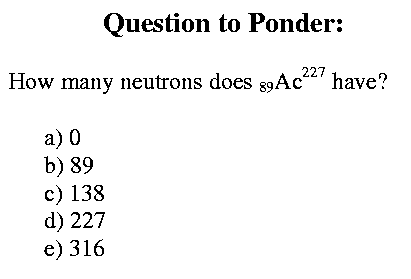|
|
O sun! Burn the great sphere thou mov'st in; darkling stand The varying star o' the world. Shakespeare, Antony and Cleopatra IV |
Assignments:Read Chapter 28, pp. 451-467Problem Set #4 due Thursday 5pm
|

In Class:
----------------
review:
PP process - the main fusion pathway in the Sun
for one PP reaction:
mass lost = 4.75 x 10^-29 kg
4.75 x 10^-29/6.6904 x 10^-27 = 0.007
only 0.7% of the total mass involved
E = (4.75 x 10^-29 kg)(3 x 10^8 m/s)^2
= 4.28 x 10^-12 kg m^2 / s^
= 4.28 x 10^-12 Joules
- the mass "lost" is the source of energy for the Sun
- conversion from 4H's to He results in mass "loss"
- so in some odd way, the Sun really is burning up
The Sun "gives away" 3.8 x 10^26 Joules every second
(luminosity = Joules/second)
if each reaction produces 4.28 x 10^-12 Joules, then we need
3.8 x 10^26 / 4.28 x 10^-12 reactions every second
= 8.9 x 10^37 reactions/second
each reaction involves 6.6904 x 10^-27 kg of H, so
5.9 x 10^11 kg of H are fused every second
in the process 0.007 x 5.9 x 10^11 kg of mass is
transformed into energy
= 4 billion kg of mass per second
--------------------------------------
While the pp chain is the main process occurring in the Sun, there
are other ways to fuse H
- alternate process -- CNO cycle
- use C as the "workbench" for making He
- attach H one at a time
- two convert to n, releasing a e+
- last p+ causes nucleus to split, yielding 6C12 and 2He4
- 6C12 free to do it over again
- net result:
4 1H1 --> 2He4
same as for pp chain
same mass lost
same energy released
- why doesn't this process occur as much in the Sun?
- 6C12 is highly charged (6 p+)
- hard to get a p+ close to it
- more repulsion
--> need higher speeds to make a close enough collision
--> higher speed == higher temperature
-- Sun's not hot enough
-- in hotter stars, this happens a lot
---------------------------
These process can occur quite happily until you run out of fuel
- though the reservoir is large, the Sun contains a finite amount of H
and it will be used up after a long time.
During this long period, stars are really stable
- internal pressure and gravity are well-balanced
- stars don't swell up or shrink
- radiate at a constant rate
- everything is hunky-dory
- This stage lasts a long time
- there's lots of H in a star
--> this is the Main Sequence
MS stars are H-fusing stars
once a star gets its act together so that it's
stable, it sits on the MS for 80% of its life
Then what happens?
- problem: use up all of the H in the core
nothing left to burn
doesn't mean all of the H in the star is used up
- only H in the core is hot enough to fuse
- H in outer layers is too cool
- even a star "out of gas" is still mostly
hydrogen
- running out of gas means running out of
H IN THE CORE
With no energy generation in the core,
- there's no longer a support mechanism for the star
- gravity starts to win
- star contracts
- core can't produce energy via fusion,
but still gets hot because it's crushed.
- odd: core gets hotter once H-fusion STOPS
- there's plenty of H left outside of the core
- as the core heats up, it heats the region around it
-eventually gets hot enough for H-fusion
- "hydrogen shell fusion"
- since it's in a shell around the core,
it doesn't help support the core
-- core continues to shrink
-- heats up even more
- accelerates the H-shell fusion
- star "overheats"
- outward pressures no longer balanced by gravity
--> outward parts of the star expand A LOT
-- even though core shrinks
-- becomes a GIANT
--> even though the core is really hot, the
outer layers actually cool because of the
expansion
-- surface temperature drops to ~3000 K
-- becomes RED
--> RED GIANT STAGE
|
![]()